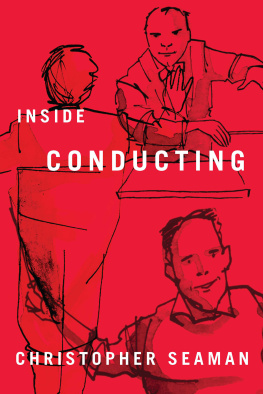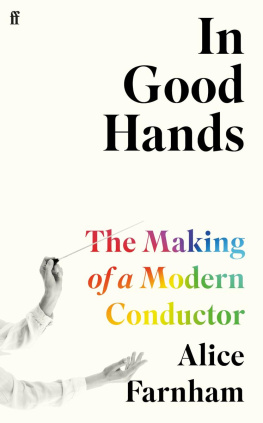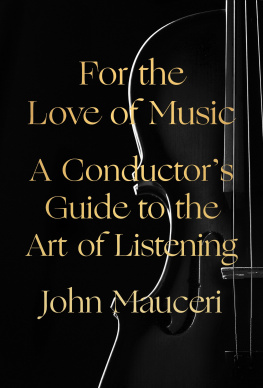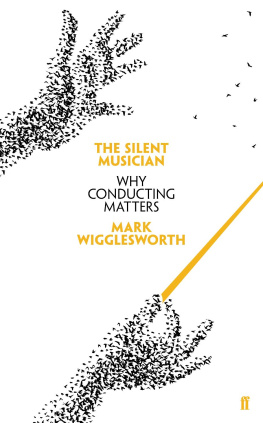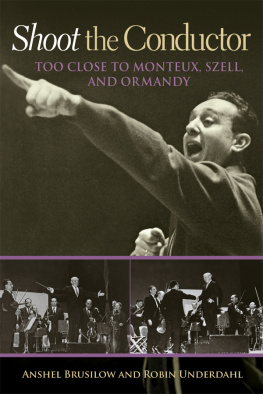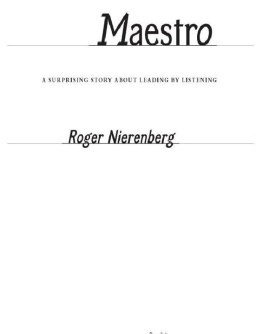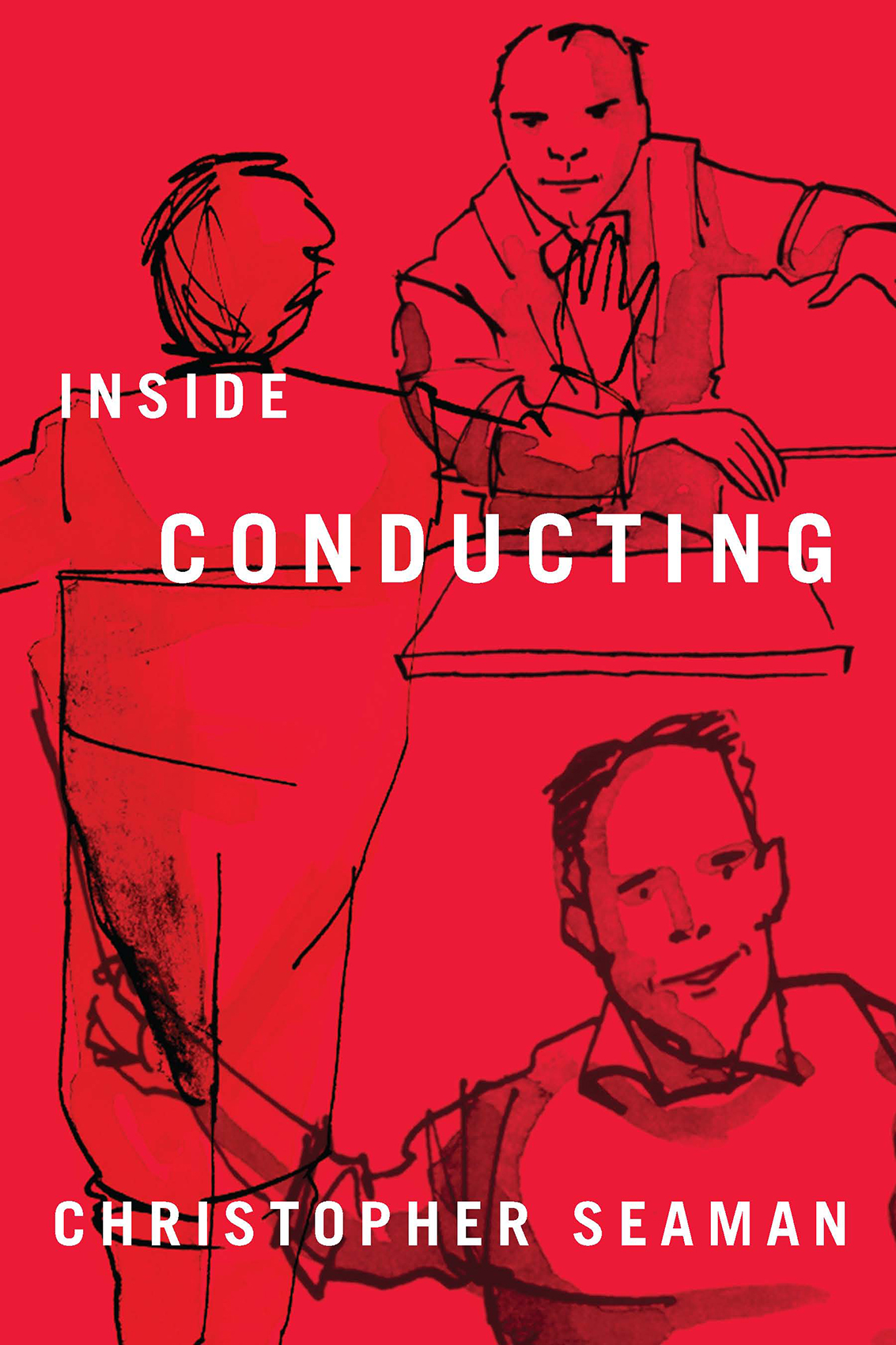With gratitude to all the orchestral musicians
whose artistry, professionalism,
and generosity of spirit enable me to make music.
Foreword

It is a great pleasure for me to introduce this book by Christopher Seaman, not just because of the book itself but also because of my more than forty-year relationship with him. I first met Christopher when he was chief conductor of the BBC Scottish Symphony Orchestra. He invited me to conduct a concert, and I was overwhelmed by his generosity of spirit, both during rehearsals and after the concert. During the years that followed I was privileged to connect with Christopher on many levels, both as a conductor and as a highly stimulating teacher, and I noted in particular his ability to solve any problem that arose, both musically and personally.
Christopher is a true friend and a rare personality. There is no one in whose hands I would rather place any good orchestra and whose expertise I could recommend more highly. His good humor, sensitivity, and piercing intelligence never flag; and his knowledge of his trade is unsurpassed.
All of these qualities can be found in this book. Christopher Seaman s Inside Conducting is a unique look at the art, practice, and business of conducting as seen from the perspective of a master conductor and a former orchestral player. It is a highly detailed, informative, and entertaining compendium of every aspect of the profession, told in a simple and direct manner, which will undoubtedly find its way onto every aspiring conductor s bookshelf. It will also be of great interest to anyone who attends concerts and wonders what it is that really creates the magic between the conductor and his orchestra.
I personally want to thank Christopher for finally sharing his knowledge with all of us.
David Zinman , 2013
Chief Conductor, Tonhalle-Orchester Zrich
Preface

What does a conductor actually do? How much effect does he or she have? Can the orchestra manage without one? Why don t the players look at the conductor more? Is it necessary for the conductor to play every instrument? What about interpretation? What happens at rehearsals? Why do some conductors thrash around more than others; does it mean theyre more talented or more involved? Who s the boss in a concerto, the soloist or the conductor? How do the orchestra members manage to play together for somebody whose beat looks unclear? How does a young conductor learn the job and start a career?
These are some of the questions I ve addressed in this book; they appear as topics (e.g., beat, ear, ego, memory, nervousness, rehearsing, tempo) under various headings (e.g., The Conductor s Mind, The Conductor and the Musicians, The Conductor, the Composer, and the Score). Each article begins with an anecdote or saying and ends with quotes from musicians, often expressing opposing views. Naturally, many topics are interrelated. Some are more technical than others, but they are all accessible to music lovers. There are suggestions for further reading and the occasional cartoon.
I feel strongly that we need to keep our connection with the great conductors of the past who ve passed the baton on to us. As a young player, I was fortunate enough to work with Charles Munch , Jascha Horenstein , Vittorio Gui , and Adrian Boult all of whom were around in the days of Arthur Nikisch (a favorite of Tchaikovsky ), Fritz Steinbach (a favorite of Brahms ), and Hans Richter ( Wagner s assistant). I knew musicians who played for all three of these men. Many of my references and quotes refer to previous generations of conductors, partly because everybody knows about present-day conductors through the Internet and media but chiefly because ignoring links with the past impoverishes every art.
A word about the stories I tell. Some (as I indicate) come from books by or about various noted conductors. Some are anecdotes that I have heard (once or many times). I find that, even if an anecdote is not utterly reliable as historical fact, it can reveal some basic truth about how conductors feel or tend to be perceived. And occasionally, I share a joke that I made up myself to convey what it is like to play in an orchestra or to stand in front of one.
A brief comment on gender: I ve found it simplest to use he as a pronoun. To alternate he with she, to say he or she every time, or even to use the device (s)he seems to spoil the flow of the text. One of the articles is entitled Gender.
My four years as principal timpanist of the London Philharmonic Orchestra followed by over forty years as an international conductor have taught me a lot. Having been at both ends of the baton, I ve had the privilege of playing for some great conductors and conducting many great orchestras, often working with leading soloists. Much of this experience has gone into this book. It isn t an autobiography, although I often refer to my experiences. It isn t a textbook, because the hints I give to young conductors are well within the grasp of a lay enthusiast. I aim to provide interest and understanding for music lovers, to heighten the experience of attending a concert, and to help some young conductors do their job better. If I ve gone some way toward achieving that, I shall be gratified.

Part One
The Conductor s Mind
Background

One
Bravo, Christopher, you did a good job. You know, I think you should give up music and take up conducting! A London Philharmonic colleague jokingly made this suggestion after playing in a small concert I conducted while still a member of the orchestra.
Conductors come from a wide variety of musical backgrounds. A tiny handful have so much talent and aptitude that they can shortcut parts of a traditional training and produce superb work by sheer musical instinct. But the vast majority need training and experience in a number of key areas.
Playing an instrument at a high standard is vital as it develops physical coordination, discipline, a good ear, and the ability to create a performance. Keyboard skills are useful, even if the piano isn t your main instrument. In a traditional European opera house, most staff conductors began as pianists ( rptiteurs ) before working their way up to conducting. Playing the piano gives you a strong sense of harmony, a key ingredient in the shape and structure of a piece. Learning piano music by great composers helps you better understand their orchestral music. Keyboard skills are also useful in studying scores, especially in the early stages while youre learning the notes. Working as an accompanist heightens sensitivity and quickens reactions. You learn a lot from playing for instrumentalists and singers; breathing with them teaches you to breathe with a whole orchestra.
A knowledge of musical theory and musical history is part of every conductor s equipment. Harmony, counterpoint, composition, orchestration, form, and musical style are all included, because they give insight and skill in handling every kind of music. A general knowledge of history, literature, and the other arts will further deepen a conductor s understanding of a work s background. He needs to listen to as much music as possible, not only orchestral but also opera, chamber music, and the vocal repertory. It s important to understand how every piece would have sounded at the time it was written, with the style of playing and the instruments of the period. I discuss this in Performance Practice. Academic knowledge, if wisely and enthusiastically imparted, will give any conductor a greater love and regard for music and help him perform it with integrity and depth.

